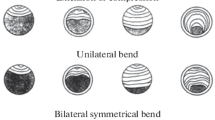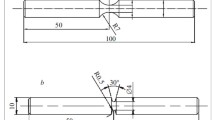Abstract
Industrial equipment is usually high in cost. Design engineering needs to specify fuses that have the role of protecting the main parts of the equipment. The aim of this work is to identify the reason that led to a high number of fractures in mechanical fuses of a rolling mill and suggest improvements to fix the problem. Two components were analyzed: one that failed and one that was used inside the equipment but did not fail. According to their datasheet, the components are made of quenched and tempered type 4140 (UNS G41400) steel. Chemical analysis of the fuse was performed using x-ray fluorescence. Microstructural and fractographic aspects were investigated by optical and scanning electron microscopy. The existence of surface cracks is investigated by liquid penetrant test. Tensile analyses in the component are made using analytical and numerical methods. Numeric analyses are performed by the finite element method. The chemical analysis is in agreement with that expected for type 4140. The fractographic analysis shows intergranular brittle fracture. No surface cracks are found by the liquid penetrant, and no evidence of fatigue mechanism fracture is found the fractographic analysis. All results indicate that the component fractured due to the action of overload. By comparing the numerical and analytical methods, it is possible to identify that the stress concentration in the fuse analyzed results has a value of 9.44% lower when the analytical method is used. It is possible to conclude that the analytical method causes an error in the design, which was not covered by the safety factor because mechanical fuses did not use a safety factor in their projects. Increasing the radius of stress concentration can compensate the error, without requiring dimensional changes in the component. A new component is manufactured according to this concept, which is in operation without any issues.






Similar content being viewed by others
References
ASM, ASM Handbook, Fractography, vol. 12 (ASM International, Cleveland, 1987)
R.L. Norton, Projeto de máquinas (Bookman Editora, Porto Alegre, 2013)
D. Taylor, A. Kelly, M. Toso, L. Susmel, The variable-radius notch: two new methods for reducing stress concentration. Eng. Fail. Anal. 18, 1009–1017 (2011). https://doi.org/10.1016/j.engfailanal.2010.12.012
A. Murdani, C. Makabe, A. Saimoto, Y. Irei, Stress concentration at stop-drilled holes and additional holes. Eng. Fail. Anal. 15(7), 810–819 (2008)
A.J. Pachoud, P.A. Manso, A.J. Schleiss, New parametric equations to estimate notch stress concentration factors at butt welded joints modeling the weld profile with splines. Eng. Fail. Anal. 72, 11–24 (2017)
Y. Sun, J. Zhai, Q. Zhang, X. Qin, Research of large scale mechanical structure crack growth method based on finite element parametric submodel. Eng. Fail. Anal. 102, 226–236 (2019)
G. Zheng, J. Sun, T. Zhang, Q. Fan, Y. Diao, H. Zhou, Eulerian finite element model for stability analysis of circular tunnels in undrained clay. Eng. Fail. Anal. 91, 216–224 (2018)
X. Chang, Y. Peng, Z. Zhu, X. Gong, Breaking failure analysis and finite element simulation of wear-out winding hoist wire rope. Eng. Fail. Anal. 95, 1–17 (2019)
D. Taylan, T. Aydin, Analysis of dynamic behavior of Darideresi-II Dam by ANSYS. Nat. Hazard. 90(3), 1223–1235 (2018)
M. Pilar, V. González, A.G. Meije, M.G. Martínez, Determination of the fracture cause in an aircraft motor cylinder. Eng. Fail. Anal. 82, 816–822 (2017)
A.H. Meysami, R. Ghasemzadeh, S.H. Seyedein, M.R. Aboutalebi, An investigation on the microstructure and mechanical properties of direct-quenched and tempered AISI 4140 steel. Mater. Des. 31(3), 1570–1575 (2010)
ISO 6508-1, Metallic materials—Rockwell hardness test—Part 1: test method (2016)
ASM, ASM Handbook, Fatigue and Fracture, vol. 19 (ASM International, Cleveland, 1996)
J.L. McCall, Fracture Analysis by Scanning Electron Microscopy (Metals and Ceramics Information Center, Gaithersburg, 1972)
ASM, ASM Handbook, Heat Treating of Irons and Steels, vol. 4D (ASM International, Cleveland, 2014)
S.S.M. Tavares, J.M. Pardal, J.A. De Souza, O.C. Pereira, T.S. Luz, Failure of alloy steel socket-head cap screws used in offshore oil production. Eng. Fail. Anal. 70, 16–21 (2016)
C. Sasikumar, S. Srikanth, Analysis of premature failure of a tie bar in an injection molding machine. Eng. Fail. Anal. 13(8), 1246–1259 (2006)
J.A. Collins, Failure of Materials in Mechanical Design: Analysis, Prediction, Prevention (Wiley, Hoboken, 1993)
Acknowledgments
This study is supported by Federal Institute of Education, Science and Technology of Rio de Janeiro (PIBICT/PROCIENCIA 2019-2020), Fundação Carlos Chagas Filho de Amparo à Pesquisa do Estado do Rio de Janiero—FAPERJ (E-26/290.066/2018).
Author information
Authors and Affiliations
Corresponding author
Additional information
Publisher's Note
Springer Nature remains neutral with regard to jurisdictional claims in published maps and institutional affiliations.
Rights and permissions
About this article
Cite this article
Pimenta, A.R., Tavares, S.S.M., Diniz, M.G. et al. Finite Element Analysis of a Mechanical Fuse Failure. J Fail. Anal. and Preven. 20, 370–375 (2020). https://doi.org/10.1007/s11668-020-00839-4
Received:
Revised:
Published:
Issue Date:
DOI: https://doi.org/10.1007/s11668-020-00839-4




